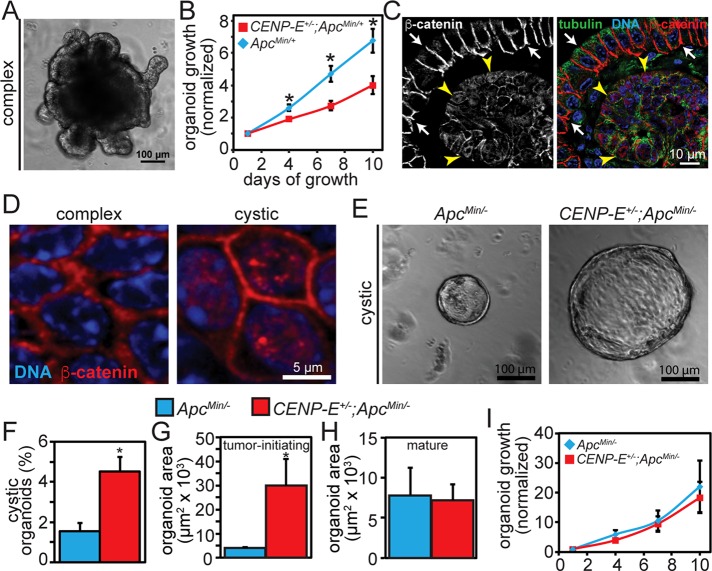FIGURE 4:
High CIN does not suppress tumor initiation in the small intestine. (A) Intestinal organoid with a branched, complex morphology typical of organoids retaining expression of wild- type APC. (B) Consistent with the elevated rates of cell death observed in CENP-E+/−;ApcMin/+ MEFs and animals, complex organoids from CENP-E+/−;ApcMin/+ animals increase in size more slowly than ApcMin/+ organoids; n = 30 ApcMin/+ and 40 CENP-E+/−;ApcMin/+ organoids. (C) The layer of normal intestinal epithelium (white arrows) surrounding an intestinal tumor (yellow arrowheads) exhibits cell surface β-catenin staining, whereas β-catenin also exhibits nuclear localization in the tumor cells. (D) As in intact intestine, β-catenin localizes predominantly to the cell surface in complex organoids (left). In cystic organoids (right), β-catenin also shows nuclear staining, consistent with Apc loss and constitutive activation of Wnt signaling. (E) Cystic organoids, which are characteristic of Apc loss (Fatehullah et al., 2013; Onuma et al., 2013), show a rounded appearance that is distinct from the complex, branched structure of organoids expressing APC, as shown in A. Cystic organoids from CENP-E+/−;ApcMin/− tumor-initiating cells are substantially larger than cystic ApcMin/− organoids derived from ApcMin/+ littermates on day 4 after plating. (F) A higher percentage of cells from CENP-E+/−;ApcMin/+ than ApcMin/+ small intestine form cystic organoids characteristic of Apc loss, demonstrating that high CIN does not inhibit tumor initiation in this context; n = 1782 organoids from ApcMin/+ and 1514 organoids from CENP-E+/−;ApcMin/+ animals. (G) Cystic organoids from tumor-initiating cells generated from CENP-E+/−;ApcMin/+ normal intestinal epithelium are substantially larger on day 4 after plating than cystic organoids from ApcMin/+ littermates. (H) In contrast, cystic organoids from mature CENP-E+/−;ApcMin/– tumor cells from adenomas of CENP-E+/−;ApcMin/+ animals show no such growth advantage, suggesting that tumor-initiating cells are less sensitive than mature tumor cells to high CIN. (I) Growth rates of cystic organoids from tumor-initiating cells for the 10 d after sizes were measured in G, showing that CENP-E+/−;ApcMin/- tumor-initiating cells rapidly lose their early growth advantage. *p < 0.05.

